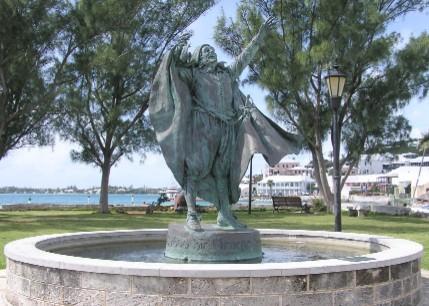
 By Raj Bhattacharya By Raj Bhattacharya
Raj, a seasoned travel writer and Bermuda destination expert, has extensive global travel experience. This website reflects his profound insights, garnered over nearly two decades of dedicated findings and research on the island. Raj has assisted countless Bermuda-bound visitors by providing direct, personalized responses to their queries and imparting his wealth of knowledge through this platform. This site serves as an indispensable guide for those seeking informed and reliable insights into Bermuda's treasures.
Know more about Raj Bhattacharya
|
Visitors' Reviews and Stories
Martin Nelson (January 2021)
Hi Raj, a question- While my mother was in Bermuda, she worked for the censorship department- I didn't realize until recently how important that was. Do you have any information or references about it at that time? My Best Wishes.
Raj (bermuda-attractions.com) January 2021
Hi Martin, around 1,000 British censors (mostly women) were appointed in Bermuda in 1940s during the World War II. All postal mails that were sent between America and Europe were intercepted at Bermuda by the British for scrutiny.
The censors mostly worked out of Hamilton Princess Hotel located on Pitts Bay Road, near Hamilton City... that is where the Censorship Station was set up. Most censors and their families were accommodated in Hotel Princess, Bermudiana Hotel and Hotel Inverurie.
About 3 weeks of training were imparted to the recruits (1 week of basic training plus two weeks of specialized training), however, supervisors and senior consultants continued to provide on the job training and answered questions that were raised by the recruits. The censors who handled specialized materials such as financial or business mails were imparted additional training and they had to go through specialized courses. Some of the examiners were also trained in different languages. Best wishes,
Michael Bradshaw (June 2015)
Hi, I am Black Bermudian with the usual mix of British- Caribbean- African ancestry to produce the multi-culturalist of today. Your site and almost all others are silent on how Bermuda evolved peaceably and steadily to the friendly bi-racial entity almost classless society we have. Much of this was due to impacts of the trans-Atlantic fraternal organizations known as the 'friendly societies'. They started the Cup match but it is often forgotten. They anchored the transition from a British only to a more cosmopolitan island; from slavery society to a post-emancipation worldview. They express the links between North American (USA and Canadian) and European peoples with the Caribbean with Bermuda at the centre of the wheel.
Ewelina Suwada (May 2013)
My name is Ewelina, and I'm a student of Applied Linguistics from European University in Cracow, Poland. I was wondering if it is possible for you to answer a couple of questions:
1) What are the most important historic facts about Bermuda and St. George’s?
2) Does the history affect the present? If yes, how? Is anyone trying to remind about the past? Any museums, exhibitions, events, famous people who give Bermuda a great piece of promotion?
3) Are the tourists interested in the historical part of the island? If they are, in what particular monuments especially?
Raj (bermuda-attractions.com) May 2013
Hi Ewelina, here are my responses to your questions:
1) 1609 was the year when the real history of the island began and marked the most important historical milestone of Bermuda and St George. This is when the ship Sea Venture of Sir George Somers was hit by a severe storm when he was sailing on a mission from England to colonize Jamestown. But along the way, the storm separated his ship from rest of the fleet. As a result they had to steer the ship towards the nearby island Bermuda, then an uninhabited and unnamed island. While navigating towards the island, the ship was wrecked by an offshore reef close to St George's , however Somers and his 150 crew members managed to reach the shore of St George's and survived. This in fact marked the first human settlement in the Island. Although Somers and his men later built another ship and sailed towards Jamestown, they left behind three persons to retain the claim on the island and later in 1612, the official British settlement began under the command of Sir Richard Moore.
The next major historical time was when slaves were brought into the island in 1620s soon after the British colony was formed. They were mostly West Indians, Latin Americans and African blacks, as well as native Americans, Irish and Scots. Over a period of time the island which predominantly had whites, had an even mix of blacks and whites. Although slaves were all freed in 1834, many islanders today can relate their ancestry to African blacks and Europeans.
Another important historical milestone was the construction of Royal Naval Dockyard in 1809 in Sandys parish. The British had to build this navy base after they lost the American war of Independence. This navy base remained in operation for well over 100 years and through even the World War II until it was closed down finally in 1995. It has now become the major port for the cruise ships visiting Bermuda bringing in loads of tourists. It has many historical buildings, landmarks and museum that reflect the period of Royal Navy and their influence in the island.
2) There are several museums, monuments and exhibits that reflect the rich history of Bermuda. The World Heritage Center in St George provides a complete background and history of St George through its various stages and how it became the UNESCO World Heritage Site in the year 2000. It uses many miniature models, videos, dioramas and exhibits to portray this story.
The vivid stories and lives of the slaves during slavery period are captured by many landmarks, monuments and museums that are part of African Diaspora Heritage Trail in Bermuda. You will find complete information here: African Diaspora Heritage Trail
3) Significant number of visiting tourists take keen interest in the history of Bermuda. They visit the heritage town of St George and go through many historical buildings, churches and museums. Starting from the World Heritage Center, they visit many other popular landmarks. Some of them include:
Model of the ship Deliverance (which was built in the island by Somers and his men to sail for Jamestown), Bermuda National Trust Museum, St Peter's Church, Old State House, St George's Historical Society Museum, Fort St Catherine and more.
To understand the slavery period in Bermuda, tourists trace the African Diaspora Heritage trail and visit all the monuments, places and museums that I have described under the section: African Diaspora Heritage Trail
To know about the Royal Naval Base, its operation and importance to Bermuda, tourists visit the National Museum of Bermuda (formerly Bermuda Maritime Museum). For details, go through: Bermuda Maritime Museum
Hope this helps.
Doug (September 2012)
My dad was stationed in Bermuda in the 40's . He was a radio man in the Air Force . Any ideas where to go ? Would like to see where he was, he always wanted to go back and never made it.
Raj (bermuda-attractions.com) September 2012
Hello Doug, The Air Force base in Bermuda was developed jointly by US Air Force and the British Royal Air Force at Kindley Field, St. George where the present airport is located. It came up in 1944 during World War II. This is where most air force personnel were located. There was also a NASA tracking station built at Cooper's Island (in St Davids) where a small number of Air force Radio persons were located.
May be, you would like to visit both these places. Here are couple of links where I've shared our own experiences there:
|